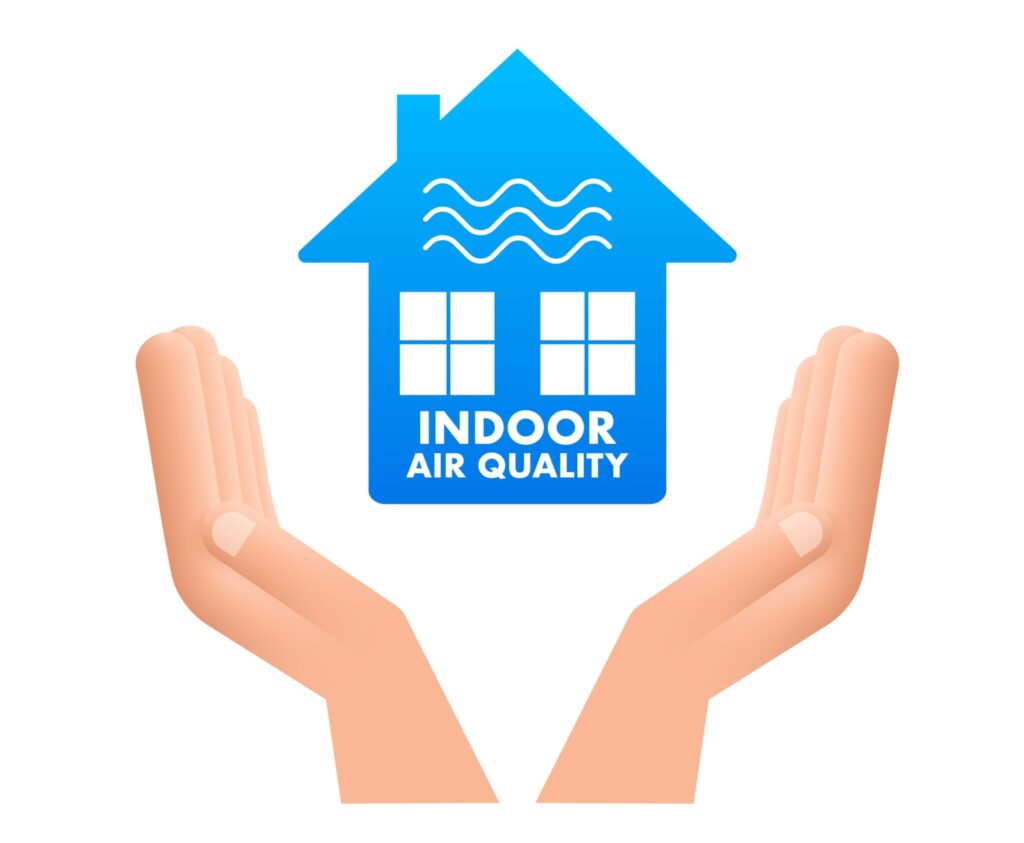
Indoor Air Quality and Its Impact on Allergies
Indoor air quality (IAQ) significantly impacts overall health, particularly for individuals with allergies. Here’s how good IAQ can make a difference:
- Reducing Allergens: Effective IAQ management reduces common indoor allergens like dust mites, pet dander, and mold spores, which are typical triggers for allergy sufferers.
- Preventing Respiratory Problems: Good IAQ minimizes pollutants that can irritate the respiratory tract, such as particulate matter and volatile organic compounds (VOCs), reducing symptoms like coughing, sneezing, and shortness of breath.
- Long-Term Health Benefits: Maintaining optimal indoor air quality can help prevent more severe health issues linked to poor air quality, including chronic respiratory diseases and, potentially, heart conditions or cancer.
- Improving Comfort and Productivity: Clean indoor air contributes to a more comfortable living and working environment, enhancing well-being and productivity.
- Economic Advantages: Investing in good IAQ can lead to lower healthcare costs by mitigating health risks associated with air quality issues and enhancing property value through better maintenance of indoor environments.
Have you ever wondered why indoor air quality matters?
Indoor air quality (IAQ) refers to the condition of the air inside buildings and structures, particularly as it relates to the health and comfort of occupants. Good IAQ is essential for a healthy living environment and involves managing indoor pollutants, humidity, and ventilation to ensure the air you breathe is clean and safe.
Indoor air quality encompasses various factors, including temperature, humidity, ventilation, and the presence of pollutants. These pollutants can be physical, chemical, or biological. Understanding these elements is the first step toward maintaining a healthy indoor environment.
Importance of Good Indoor Air Quality
Do you know how much time you spend indoors and how it affects your health? The quality of the air inside our homes and workplaces plays a crucial role in our overall well-being. Good indoor air quality is vital for maintaining health, comfort, and productivity. It ensures that the air we breathe indoors is free from harmful pollutants, allergens, and contaminants.
Health Benefits of Good Indoor Air Quality
Breathing clean air indoors can prevent a range of health issues. Poor indoor air quality can lead to respiratory problems, exacerbate allergies, and even contribute to long-term health risks such as heart disease and cancer. On the other hand, good IAQ can reduce these risks, promoting better respiratory health, fewer allergy symptoms, and a lower incidence of chronic illnesses.
Comfort and Productivity
Good indoor air quality also enhances comfort and productivity. When the air is clean and fresh, it creates a pleasant environment that can improve concentration and efficiency. Poor air quality, however, can cause discomfort, headaches, and fatigue, reducing your ability to work effectively and enjoy your time at home.
Protecting Vulnerable Populations
Children, the elderly, and individuals with preexisting health conditions are particularly vulnerable to the effects of poor indoor air quality. Ensuring good IAQ in homes, schools, and healthcare facilities is essential to protect these groups from the harmful effects of indoor pollutants. This proactive approach can significantly improve their quality of life and health outcomes.
Economic Impact
Investing in good indoor air quality can also have economic benefits. Reducing the incidence of health issues related to poor IAQ can lower healthcare costs and increase productivity in workplaces. Moreover, maintaining good IAQ can enhance the value of properties, making them more attractive to potential buyers or renters.
Common Pollutants in Indoor Air
Are you aware of the hidden dangers in the air you breathe at home? Indoor air can harbor various pollutants that impact health and comfort. Understanding these common pollutants is essential for managing and improving indoor air quality.
Biological Pollutants
Biological contaminants include mold, mildew, pet dander, dust mites, bacteria, and viruses. These pollutants can cause allergic reactions, respiratory problems, and infections. High humidity levels can exacerbate the growth of mold and mildew, making it crucial to control indoor moisture.
Volatile Organic Compounds (VOCs)
VOCs are emitted by household products such as paints, cleaners, and furniture. These compounds can cause headaches, dizziness, and long-term health effects, including liver and kidney damage. Common sources of VOCs include:
- Paints and solvents
- Aerosol sprays
- Cleaning products
- Building materials
Particulate Matter (PM)
Particulate matter consists of tiny particles or droplets in the air, such as dust, dirt, soot, and smoke. PM can penetrate the respiratory system, causing irritation, respiratory infections, and cardiovascular issues. Sources of particulate matter include:
- Cooking
- Smoking
- Fireplaces
- Outdoor air pollution
Carbon Monoxide (CO)
Carbon monoxide is a colorless, odorless gas that can be deadly in high concentrations. It is produced by burning fossil fuels in appliances like gas stoves, fireplaces, and heaters. Symptoms of CO exposure include headaches, dizziness, weakness, and, in severe cases, death.
Radon
Radon is a radioactive gas that can seep into homes from the ground. Long-term radon exposure can lead to lung cancer. Radon levels vary by geographic location, making it important to test homes in areas known for high radon levels.
Lead
Lead particles can come from old paint, contaminated soil, and dust. Ingesting or inhaling lead particles can cause serious health problems, particularly in children, including developmental delays and cognitive impairments.

How Indoor Air Quality Affects Health
Have you ever considered how the air inside your home might be affecting your health? Indoor air quality (IAQ) has a significant impact on our well-being, influencing both short-term comfort and long-term health. Poor IAQ can lead to a range of health issues, from minor irritations to serious chronic conditions.
Respiratory Issues
One of the most immediate effects of poor indoor air quality is respiratory problems. Pollutants such as dust, mold spores, and volatile organic compounds (VOCs) can irritate the respiratory system, leading to symptoms like coughing, sneezing, and shortness of breath. Long-term exposure can worsen asthma and other chronic respiratory conditions.
Impact on Allergies
For individuals with allergies, poor IAQ can exacerbate symptoms. Common indoor allergens include pet dander, dust mites, and mold. These allergens can cause sneezing, itching, watery eyes, and even skin rashes. Maintaining good indoor air quality by reducing these allergens can significantly improve the quality of life for allergy sufferers.
Long-Term Health Risks
Prolonged exposure to indoor pollutants can have serious long-term health consequences. For instance, exposure to radon gas, a common indoor pollutant, is a leading cause of lung cancer in non-smokers. Similarly, long-term exposure to VOCs can lead to liver, kidney, and central nervous system damage. Children and the elderly are particularly vulnerable to these effects, making it crucial to monitor and improve IAQ.
Sources of Indoor Air Pollution
Understanding the sources of indoor air pollution can help in managing and reducing health risks. Common sources include:
- Household cleaning products: Many cleaning agents release harmful chemicals into the air.
- Mold and mildew: These thrive in damp environments and can cause respiratory issues.
- Pet dander: Pets shed tiny particles of skin that can trigger allergies.
- Dust mites: These microscopic creatures live in household dust and can cause allergic reactions.
Sources of Indoor Air Pollution
Do you know where indoor air pollution comes from in your home? Identifying the sources of indoor air pollution is essential for maintaining a healthy living environment. Various common household items and practices contribute to poor indoor air quality.
Household Cleaning Products
Many cleaning products release volatile organic compounds (VOCs) into the air. These chemicals can irritate the respiratory system, cause headaches, and contribute to long-term health problems. Common culprits include:
- Aerosol sprays
- Disinfectants
- Bleach-based cleaners
Opting for natural or low-VOC cleaning products can help reduce indoor air pollution.
Mold and Mildew
Mold and mildew thrive in damp environments and can release spores into the air. These spores can trigger allergies and respiratory issues. Common places for mold growth include:
- Bathrooms
- Basements
- Kitchens
Ensuring proper ventilation and addressing any leaks or damp areas promptly can help prevent mold growth.
Pet Dander
Pets can be a significant source of indoor air pollution. Pet dander, composed of tiny skin flakes, can cause allergic reactions in sensitive individuals. Regular grooming and cleaning can help reduce the amount of pet dander in your home.
Dust Mites
Dust mites are microscopic creatures that live in household dust. They thrive in warm, humid environments and can cause allergic reactions. They are commonly found in:
- Bedding
- Upholstered furniture
- Carpets
Regular vacuuming, using dust mite covers, and washing bedding in hot water can help control dust mite populations.
Combustion Pollutants
Combustion pollutants come from burning fuels such as gas, wood, and coal. Common sources include:
- Gas stoves
- Fireplaces
- Furnaces
These pollutants can include carbon monoxide (CO) and nitrogen dioxide (NO2), which are harmful to health. Proper ventilation and regular maintenance of appliances can help minimize these pollutants.
Building Materials
Certain building materials and furnishings release VOCs and other harmful chemicals. These materials include:
- Paints
- Adhesives
- Carpeting
Choosing low-VOC or non-toxic building materials can improve indoor air quality.
Understanding these sources of indoor air pollution is the first step in mitigating their impact. By taking proactive measures to reduce or eliminate these pollutants, you can create a healthier and safer indoor environment for you and your family.
Impact of Poor Indoor Air Quality on Allergies
Did you know that the air inside your home could be making your allergies worse? Poor indoor air quality (IAQ) can significantly impact allergy sufferers, leading to a range of uncomfortable symptoms and long-term health issues. Understanding how poor IAQ affects allergies can help you take steps to improve the air you breathe.
Types of Allergens
Indoor allergens are substances that can cause allergic reactions. Common indoor allergens include:
- Pet dander: Tiny flakes of skin shed by pets.
- Dust mites: Microscopic creatures living in dust.
- Mold spores: Released by mold and mildew.
- Pollen: Can enter homes from the outside.
- Cockroach droppings: Can trigger allergies and asthma.
These allergens can accumulate in various places within your home, such as carpets, bedding, and furniture, contributing to poor IAQ.
Symptoms of Allergies
Exposure to indoor allergens can trigger a variety of symptoms, including:
- Sneezing and coughing
- Runny or stuffy nose
- Itchy or watery eyes
- Skin rashes or hives
- Wheezing or shortness of breath
These symptoms can range from mild to severe, significantly affecting your quality of life.

Monitoring Indoor Air Quality
Have you ever wondered how to keep track of the air quality inside your home? Monitoring indoor air quality (IAQ) is crucial for ensuring a healthy living environment. There are several methods to monitor and assess the quality of air indoors, from professional testing to DIY solutions.
Tools and Devices
There are various tools and devices available that can help you monitor your indoor air quality effectively. These tools can detect and measure pollutants, giving you a clear understanding of your home’s air quality.
- Air Quality Monitors: These devices can measure a range of pollutants, including particulate matter (PM), carbon dioxide (CO2), volatile organic compounds (VOCs), and humidity levels. Some advanced models provide real-time data and alerts.
- Carbon Monoxide Detectors: Essential for detecting dangerous levels of carbon monoxide, these detectors can alert you to the presence of this odorless, colorless gas.
- Radon Test Kits: Radon is a radioactive gas that can seep into homes from the ground. Test kits can help you measure radon levels and determine if mitigation is needed.
Professional Air Quality Testing
For a comprehensive assessment of your indoor air quality, consider hiring a professional service. Professional air quality testing provides a thorough analysis of various pollutants and offers recommendations for improvement.
- Detailed Reports: Professionals can identify specific pollutants and their sources, providing detailed reports that can guide remediation efforts.
- Expert Recommendations: Based on the results, professionals can suggest effective strategies to improve IAQ, such as better ventilation, air purifiers, or changes in cleaning habits.
- Regular Testing: Regular professional testing, especially in areas with known air quality issues, ensures ongoing monitoring and maintenance of healthy air quality levels.
DIY Testing Methods
If professional testing is not an option, there are several DIY methods to monitor indoor air quality.
- DIY Test Kits: Affordable test kits are available for detecting specific pollutants like mold, radon, and VOCs. While not as comprehensive as professional testing, these kits can provide useful insights.
- Visual Inspections: Regularly inspect your home for visible signs of mold, dust accumulation, and water damage. Addressing these issues promptly can prevent further air quality deterioration.
- Smart Home Devices: Some smart thermostats and home automation systems come with built-in air quality sensors. These devices can provide continuous monitoring and alerts directly to your smartphone.
Improving Indoor Air Quality
Are you ready to make your home’s air healthier and cleaner? Improving indoor air quality (IAQ) is essential for a comfortable and healthy living environment. There are several effective methods to enhance IAQ, from ventilation solutions to using air purifiers.
Ventilation Solutions
Proper ventilation is crucial for maintaining good indoor air quality. It helps to dilute indoor pollutants and bring in fresh air from outside.
- Mechanical Ventilation: Systems like exhaust fans, whole-house fans, and heat recovery ventilators (HRVs) can help remove stale air and bring in fresh air.
- Natural Ventilation: Opening windows and doors allows fresh air to circulate and reduces pollutant concentration. Use natural ventilation when outdoor air quality is good.
- Kitchen and Bathroom Fans: These fans help remove moisture, odors, and pollutants directly from their source. Ensure they vent to the outside and use them during and after cooking or showering.
Air Purifiers
Air purifiers can effectively remove pollutants from the air, including dust, pollen, pet dander, and VOCs.
- HEPA Filters: High-efficiency particulate Air (HEPA) filters can capture 99.97% of particles as small as 0.3 microns. They are particularly effective for removing allergens and particulate matter.
- Activated Carbon Filters: These filters are excellent for removing gases and odors. They absorb VOCs, smoke, and chemical fumes.
- UV-C Light: Some air purifiers use ultraviolet light to kill bacteria, viruses, and mold spores, improving overall air quality.
Humidity Control
Maintaining optimal humidity levels (30-50%) is vital for preventing mold growth and dust mites, which thrive in high humidity.
- Dehumidifiers: Use dehumidifiers in damp areas like basements and bathrooms to reduce humidity levels.
- Humidifiers: In dry climates, humidifiers can add moisture to the air, preventing respiratory irritation and dry skin.
- Hygrometers: These devices measure humidity levels, helping you maintain an optimal indoor environment.
Regular Maintenance for Better Air Quality
Consistent maintenance practices can significantly improve indoor air quality.
- HVAC System Maintenance: Regularly service your heating, ventilation, and air conditioning (HVAC) system. Change filters every 1-3 months to ensure efficient operation.
- Cleaning Air Ducts: Professional duct cleaning can remove accumulated dust and debris, improving airflow and reducing contaminants.
- Regular Dusting and Cleaning: Dust and vacuum your home frequently to reduce dust mites, pet dander, and other allergens. Use a vacuum with a HEPA filter for best results.
Regular Maintenance for Better Air Quality
Are you wondering how to maintain good indoor air quality consistently? Regular maintenance is key to ensuring the air in your home stays clean and healthy. By taking proactive steps, you can significantly reduce indoor pollutants and improve overall air quality.
HVAC System Maintenance
Your heating, ventilation, and air conditioning (HVAC) system plays a crucial role in indoor air quality. Proper maintenance of this system is essential for optimal performance and air cleanliness.
- Regular Inspections: Schedule annual inspections with a professional to check for any issues and ensure everything is running smoothly.
- Filter Replacement: Change HVAC filters every 1-3 months, depending on usage and the type of filter. High-efficiency filters can capture more particles, improving air quality.
- Duct Cleaning: Consider professional air duct cleaning every few years to remove dust, debris, and other contaminants that can accumulate over time.
Cleaning Air Ducts
Air ducts can collect dust, mold, and other pollutants that can be circulated throughout your home. Regular cleaning helps maintain good air quality.
- Professional Cleaning: Hire professionals to clean your ducts and ensure they are free from blockages and contaminants.
- Seal Leaks: Ensure that air ducts are properly sealed to prevent dust and pollutants from entering the system.
Regular Dusting and Cleaning
Keeping your home clean is one of the simplest yet most effective ways to improve indoor air quality.
- Dusting: Dust surfaces regularly using a damp cloth to prevent dust from becoming airborne.
- Vacuuming: Use a vacuum cleaner with a HEPA filter to effectively capture dust, pet dander, and other allergens. Vacuum carpets, rugs, and upholstered furniture at least once a week.
- Mopping: After vacuuming, mop hard floors to remove any remaining dust and allergens.
Using Plants to Improve Air Quality
Certain indoor plants can help purify the air by absorbing pollutants and releasing oxygen.
- Best Indoor Plants for Air Purification: Some effective plants include spider plants, peace lilies, and snake plants. These plants can help reduce levels of VOCs and other pollutants.
- Care Tips for Indoor Plants: Ensure plants are placed in areas with adequate sunlight and water them regularly. Dust leaves to maximize their air-purifying abilities.
- Potential Drawbacks: While plants can improve air quality, they can also harbor mold if overwatered. Monitor humidity levels and avoid overwatering.
FAQs
-
What are the main causes of indoor air pollution?
The main causes of indoor air pollution include household cleaning products, mold and mildew, pet dander, dust mites, combustion pollutants from stoves and fireplaces, and building materials like paints and adhesives. Poor ventilation can also exacerbate the concentration of these pollutants.
-
How often should I test my indoor air quality?
It’s recommended to test your indoor air quality at least once a year. However, if you notice symptoms like allergies or respiratory issues, or if there have been changes in your living environment (such as renovations), you should test more frequently.
-
Can poor indoor air quality cause long-term health issues?
Yes, prolonged exposure to poor indoor air quality can lead to serious health problems. These include respiratory diseases, heart disease, and lung cancer. Children, the elderly, and those with preexisting health conditions are especially vulnerable.
-
What can I do to improve indoor air quality?
To improve indoor air quality, ensure proper ventilation, use air purifiers, maintain optimal humidity levels, and regularly clean your home. Keep your HVAC system and air ducts well-maintained, and opt for low-VOC products for cleaning and building materials.
-
Are there local services in Frisco, TX, that can help with indoor air quality?
Yes, there are several services in Frisco, TX, that can help with indoor air quality, including professional air quality testing services, cleaning services, and local health departments that offer resources and guidance on maintaining healthy indoor environments.







